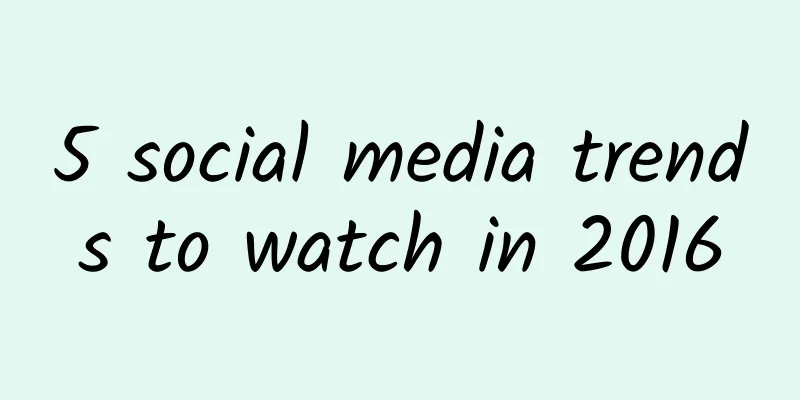5 social media trends to watch in 2016

|
In the past, we could only rely on two things: death and taxes; now we can add one: social media. Entrepreneurs will then be puzzled and wonder why this is, but they will eventually jump on the bandwagon and try to get involved. Here is a little information for you. There are 5 major trends happening in social media right now that are expected to explode in 2016. I hope it helps. 1. Live streaming becomes mainstream Live streaming is already developing, but it’s getting better. Twitter’s Periscope service has already gained 15 million registered users just a few months after its launch, allowing users to share content instantly using their smartphones. Big companies quickly spotted this opportunity, and in July 2015, GE’s Droneweek event showed the company’s factories to audiences, including how jet engines, wind turbines, and locomotives are made and tested. The company will broadcast live for a week, with real content. Other types of content that companies can live stream include: meetings, interviews, customer support, product demonstrations, and special offers. For small companies, these live viewers are loyal customers of the company. They want the most detailed information, and live streaming gives them exactly what they need. If you haven't participated in live streaming yet, I hope you will join Periscope in 2016. 2. Online platform content is more open In 2015, Facebook began to "steal" content from established content creators. In the past, publishers would direct Facebook users to their own websites, but now Facebook's Instant Articles project allows publishers to publish their content on social media platforms. Content upload speed is 10 times faster than before, more people will see it, and publishers can also earn more advertising revenue. However, users can stay on Facebook, which reduces the brand value of the publisher itself. Although this is a risk, 350 media outlets have signed on, including the New York Times, BuzzFeed and Huffington Post. More than 100 media outlets upload their content to Facebook every day through Instant Articles. The project expanded from the iPhone version to the Android version by the end of 2015. This model forced everyone to start comparing the advantages of displaying content on Facebook with the advantages of directing users to the web page. 3. Smart Uses of Snapchat Of all the social media moves, few have taken as big a risk as Snapchat. You spend time and money creating great content for your target audience, only to find that content disappears once it’s consumed. This is the polar opposite of the “explode fast, burn slow” approach achieved with YouTube videos and blogs. However, major companies such as McDonald's, Acura and Heineken have begun to intervene, wanting to cater to the platform's younger user base and fearing being left behind. The value of content has improved a lot in the last few years, and it’s getting better and better. There are now a lot of great examples of how people can quickly and easily churn out effective ephemeral content. Now, companies no longer need to think hard about good ideas and expect young users to start producing some ephemeral content. 4. Video still beats static content In 2015, news reports emerged that Facebook users posted 75% more videos than the year before. In the U.S., the number was 100%, and Facebook pushed 360% more videos to users' News Feeds than the year before. Between April and November 2015, Facebook's daily video visits increased from 4 billion to 8 billion. Even though the company defines a visit as a three-second watch, that's still a lot of people watching videos, and it looks like Facebook is about to take YouTube's job. These numbers are only going to grow. Facebook has made it clear that it prefers video content over links or images to create any kind of great social media campaign, and this year you might want to turn on your camera and start shooting video. 5. Virtual reality content will be launched When Facebook spent $2 billion to acquire Oculus Rift in 2014, social media people were confused. But Facebook's idea became clearer. Just as video is more participatory than pictures, VR content will become the next generation of more participatory content. The New York Times has begun to create VR content that can be viewed using Google's Cardboard, and Paul McCartney once invited VR companies to shoot a VR film for one of his concerts. It's too early to discuss VR content now, but by the end of this year, we can expect a new type of participatory content and then find ways to use it for ourselves. |
<<: Developers share: 7 characteristics of successful game studios
Recommend
FAW Audi dealers: Stop picking up imported and domestically produced cars in December
This winter is particularly cold for Audi and FAW...
This letter from Beijing made Awa Mountain boil!
Awa Mountain is boiling A letter from Beijing It ...
China Economic Information Service: 2017-2018 China Internet of Things Development Annual Report
The Annual Report analyzed that since 2017, the g...
How did Yuan blue and white porcelain, the ancestor of blue and white porcelain, appear and become popular in the world?
The Yuan blue and white double-handled small jar ...
Dong Mingzhu: I feel so sad that Midea won the National Science and Technology Progress Award
On March 8, Gree Electric held a press conference...
Zhihu promotion and traffic generation skills!
There is a saying that is often circulated on the...
Get started with information flow advertising!
For more basic knowledge about information flow a...
Apple's contract manufacturers are exposed for multiple violations: long working hours and low wages
The Fair Labor Association (FLA), a non-profit wa...
World Migratory Bird Day: It is said that migratory birds fly south, but where exactly does “south” refer to?
Zhong Zhenyu May 11 is World Migratory Bird Day. ...
Winter Shopping Guide: Huawei Smart Selection Double 12 is unprecedented, 3 products to help you start a smart life
Under the wave of the Internet of Things, everyth...
12 ways to make money: 100,000 yuan a year for beginners to make money with CPS projects
1) Good Project III) Course Introduction 01. The ...
When the air-conditioning industry encounters turmoil, should it engage in a price war or a quality war?
Here, several competing domestic mobile phone man...
How can I create a high-authority Zhihu account?
When I operate Baidu traffic diversion, I usually...
The three major operators all use the 17th number segment for 4G, and virtual operators benefit indirectly
On September 22, China Unicom launched 4G and use...
How much does it cost to join a metallurgical mini program in Xinxiang?
How much does it cost to join the Xinxiang Metall...









